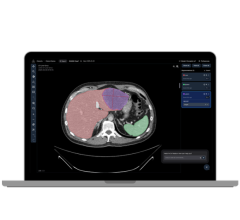
Schematic diagram for OM instrument: Seven pulsed lasers sequentially illuminate the compressed breast; transmitted light is detected by the 8-channel SiPM probe and the TDC acquires the signal. Credit: Edoardo Ferocino
April 2, 2018 — Optical mammography (OM), which uses harmless red or infrared light, has been developed for use in conjunction with X-rays for diagnosis or monitoring in cases demanding repeated imaging where high amounts of ionizing radiation should be avoided. At the OSA Biophotonics Congress: Biomedical Optics meeting, held April 3-6 in Hollywood, Fla., researchers from Milan, Italy, will report an advance in instrument development that increases the sensitivity of OM by as much as 1,000-fold.
In 2017, an estimated 252,710 new cases of invasive breast cancer were diagnosed in women and 2,470 cases were diagnosed in men1. Many of these diagnoses are made using X-ray mammography. Although standard and widely used, X-ray imaging for breast cancer suffers from both low sensitivity (50-75 percent) and the use of ionizing radiation that cannot be considered completely safe.
The newly-developed instrument replaces two photomultiplier tubes (PMTs) of existing instruments with an eight-channel probe involving silicon photomultipliers (SiPMs) and a multichannel time-to-digital converter. These changes eliminate a pre-scan step that was required to avoid damage to the PMTs. In addition to increased sensitivity, the new instrument is both more robust and cheaper.
While X-ray mammography is widely used and is still the recommended method for routine screenings, its use is limited by the patient’s age, weight or body mass index, the breast tissue itself, whether or not hormone replacement therapy is being used and other issues. In addition, its accuracy — particularly when used in younger women — has been called into question. Other breast imaging techniques, such as magnetic resonance imaging (MRI) and ultrasound, are sometimes suggested, but neither is an effective replacement for X-ray mammography.
Optical imaging methods, on the other hand, have attracted increasing interest for breast cancer diagnosis since both visible and infrared light are highly sensitive to tissue composition. Tumors are characterized by a high volume of blood due to the increased vascularization that occurs as tumors grow. OM can be used to measure blood volume, oxygenation, lipid, water and collagen content for a suspicious area identified through standard X-ray imaging. Collagen measurements are particularly important since this species is known to be involved in the onset and progression of breast cancer.
One major disadvantage to OM imaging is the poor spatial resolution that has been achieved to date. Breast cancer tumors larger than 1 centimeter are very dangerous and more likely to lead to death, so a successful screening technique must be able to resolve smaller lesions. This remains a problem with OM imaging as a stand-alone technique, but combining OM with other imaging methods shows some promise.
A possible advantage to OM, however, is that only gentle pressure need be applied to the breast tissue, in stark contrast to the standard technique for X-ray imaging. In fact, breast compression tends to reduce blood volume in the tissue, which would interfere with the OM image, so some three-dimensional OM detectors being developed use no compression at all, but rather surround the breast tissue with rings of light sources and detectors.
While poor spatial resolution of OM methods remains a challenge, the method does show promise for use in pre-surgical chemotherapy. As Edoardo Ferocino, Politecnico di Milano, Italy, co-author of the work explained, “This technique is able to provide information on the outcome of chemotherapy just weeks after beginning treatment, or possibly even sooner.” Ferocino’s group is planning clinical studies to explore the use of OM to monitor and predict the outcome of chemotherapy.
The investigators in Milan are working with a larger consortium on a project known as SOLUS, “Smart Optical and Ultrasound Diagnostics of Breast Cancer.” This project is funded by the European Union through the Horizon 2020 Research and Innovation Program and aims to combine optical imaging methods with ultrasound to improve specificity in the diagnosis of breast cancer.
For more information: www.osa.org
[1] American Cancer Society. Breast Cancer Facts & Figures 2017-2018. Retrieved from Cancer.org.


 December 08, 2025
December 08, 2025 








